Potatoes are botanically referred to as Solanum tuberosum and belong to the Solanaceae family. In this family, potatoes are among the tuber-bearing plants. Potatoes are annuals that reach a maximum height of 2 feet. Propagation occurs through underground tubers. Leaves and stems develop from the buds on tubers. There are various colors of flowers, including pink, red, white, purple, and blue, with yellow stamens. After flowering, the plant bears small, green fruits. It looks like a cherry tomato. Approximately 300 seeds are contained in each fruit.
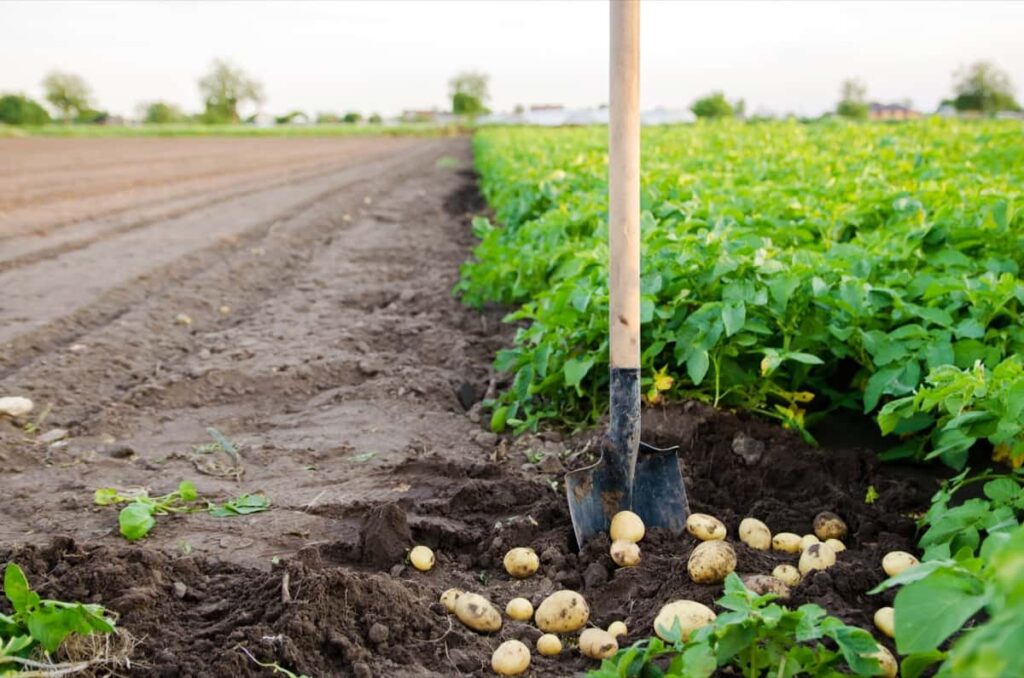
Growing Potatoes organically in Uttar Pradesh
Potato production in Uttar Pradesh and government support for organic farming
Among the states producing Potatoes, Uttar Pradesh is the largest, with 31.26% of total production, followed by West Bengal, Bihar, Gujarat, and Madhya Pradesh, with 23.29 %, 13.22%, 7.43%, and 6.20%, respectively. An organic farm generally produces potatoes as part of its rotation plan. Organic potatoes can be grown on an organic farm by a specialist potato farmer.
However, farmer registration with a certification body is still required, along with all other organic standards. Alternatively, organic crop production could be done on a single field. Through various schemes such as the National Horticulture Mission (NHM) and the Rashtriya Krishi Vikas Yojana (RKVY), the UP government encourages the production of organic crops, fruits, and vegetables. In addition, the National Project on Soil Health and Fertility (NPMSHF), the National Project on Organic Farming (NPOF), and several programs of the APEDA.
Under PKVY, organic farming is promoted through clustered organic villages and participatory guarantee systems (PGS). As part of the program, farmers receive Rs. 20,000 per acre per three years, of which 62%, or Rs. 12,000, is given as an incentive for organic farming inputs. The government is also promoting organic farming by offering Rs. 10,000 as an incentive to cultivators of organic food products under the National Horticulture Mission (NHM). 4,000/- per acre for a maximum area of 10 acres per beneficiary.
In case you missed it: How to Grow Potato Plants Faster: Best Tips to Increase Flowering, Fruiting, and Yield

Potato varieties growing in Uttar Pradesh
Kufri Alankar
It is recommended for cultivation in Punjab, Haryana, and Uttar Pradesh. The plants are tall and have thick stems. On plains, it matures in 75 days, while on hills, it takes 140 days. The tubers are oblong. A yield of 120 qtl/acre is achieved.
Kufri Badshah
There are 4-5 stems per plant, and the plants are tall. The tubers are oval-shaped, large to medium in size, and have dull white flesh. The tubers have a good flavor and are tasty. It matures between 90 and 100 days after planting. In addition to being frost-tolerant, it is also resistant to late blight and early blight. It gives a yield of 130 qtl/acre.
Kufri Bahar
Plants are tall with thick stems, 4-5 stems per plant. Tubers are large, white, round to oval in shape, and flesh is white. It matures in 90-100 days and yields 100-120 qtl/acre. Its keeping quality is average. It is resistant to late blight, early blight, leaf roll, etc.
Kufri Chamatkar
Plants are medium and spread with dark green foliage and more stems. It matures 110-120 days in plains and 150 days in hills. Tubers are round with yellow flesh. It yields 100 qtl/acre in plains and 30 qtl/acre in hills. It is resistant to late blight, brown rot, charcoal rot, and wilt.
Kufri Chipsona 2
Plants are medium tall with few stems. The foliage is dark green, and the flowers are white. Tubers are white, medium size, round, oval shape with smooth skin. Its yield of 140 qtl/acre. It is resistant to late blight. Therefore, it is highly suitable for making chips and french fries.
In case you missed it: How to Start Sweet Potato Farming in Asia: A Guide of Cultivation for Beginners

Kufri Chandramukhi
Plants are medium tall. Tubers are of oval white with dull white flesh. It is keeping quality is good. It matures 80-90 days in Plains and 120 days in hill areas. This variety gives an average yield of 100 qtl/acre in plains and 30 qtl/acre in hills. It is susceptible to late blight, brown rot, charcoal rot, and wilt.
Kufri Jawahar
Plants are short, erect, and compact with few stems; the stem is thick. The foliage is light green. Tubers are of medium-sized, round-oval shape with smooth skin. It is an early maturing variety and ready to harvest in 80-90 days. It gives a yield of 160 qtl/acre. It is not suitable for processing. It is resistant to late blight.
Kufri Sutlej
Plants are medium compact and have thick stems. Foliage is grey-green. Tubers are large with an oval shape and smooth skin. It matures in 90-100 days with an average yield is 160 qtl/acre.
Kufri Sindhuri
Plants are tall with thick stems. Tubers are round and light red in appearance. Its flesh is dull white. Its keeping quality is good. It gets mature in 120 days in plains and 145 days in hills. It gives a yield of 120 qtl/acre in plain areas. It is resistant to frost, late blight, charcoal rot, and wilts.
Kufri Alankar
It is recommended for cultivation in Punjab, Haryana, and Uttar Pradesh. Plants are tall with thick stems. It matures in 75 days in plains and 140 days in hills. Tubers are oblong. It gives a yield of 120 qtl/acre.
Soil requirements for growing Potatoes
It can grow on a wide range of soil, from sandy loam, silt loam, loam, and clay soils. It gives the best yield when grown under well-drained sandy loam and medium loam soils rich in organic content. However, they can grow in acidic soil. It cannot grow under waterlogged soil, and saline and alkaline soils are unsuitable for potato cultivation. Soil pH must be maintained between 4.8 and 5.4. It is slightly acidic to promote carbohydrate formation and storage in tubers.
In case you missed it: Best Practices to Grow Sweet Potatoes at Home: Check How this Guide Helps Beginners
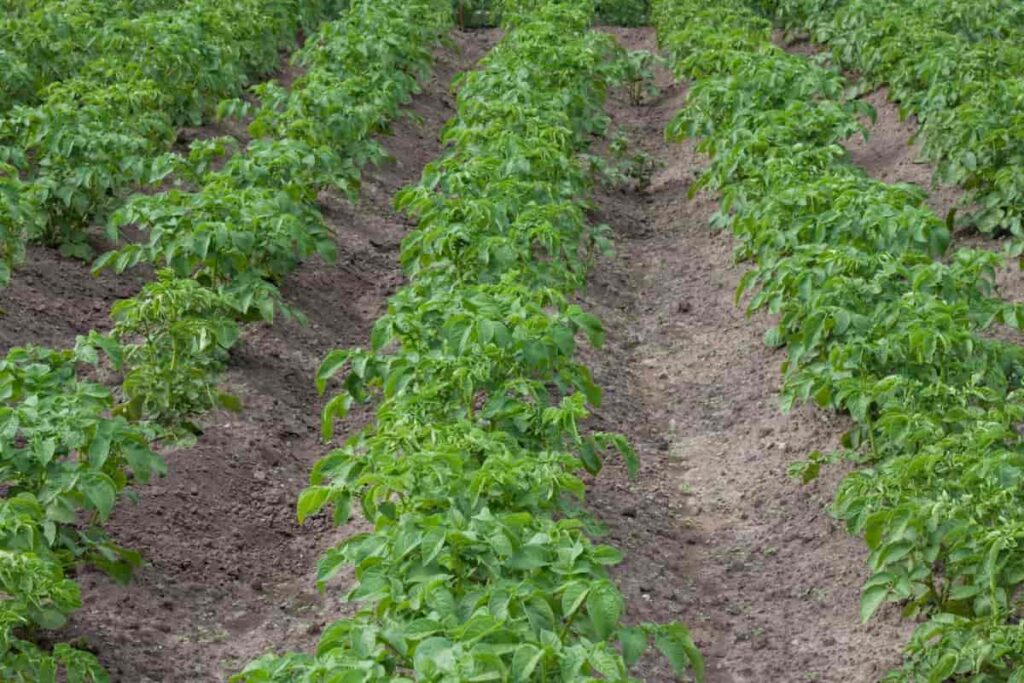
Climate and temperature requirements for Potato farming
Potato farming is most successful when the climate is excellent, the soil is fertile, and the humidity is high. Many factors influence potato growth, including temperature, light, soil type, moisture content, and nutrients. Temperatures above 30°C stop tubers from developing. As the temperature rises, the rate of respiration increases.
As a result, carbohydrates produced by photosynthesis are consumed instead of stored in tubers. At higher temperatures, tuber formation is affected. Potato tubers grow best at a soil temperature of 17-19°C. The best conditions for growing potatoes are bright sunshine during the day and cool nights. Rainfed crops are mostly grown for potato production. Rainfall levels of 1200 – 2000 mm per year are required for its cultivation.
Land preparation for Potato crop
A well-pulverized bed of 20-25 cm in depth should be plowed in the field. After plowing, harrowing should be done twice or three times. After one or two planking operations, the soil should be leveled. Make sure the soil is moist before sowing.
Time of sowing
Accurate planting time is necessary for obtaining a good yield. The best time for planting is when maximum and minimum temperatures are from 30-32°C and 18-20°C, respectively. For early season crops, complete sowing from 25th September to 10th October. For medium-duration crops, sowing should be done in the first week to the third week of October. While for late-duration crops, complete sowing from the third week of October to the first week of November.
In case you missed it: Profitable Organic Eggplant/Brinjal Cultivation in West Bengal: A Production Guide for Beginners
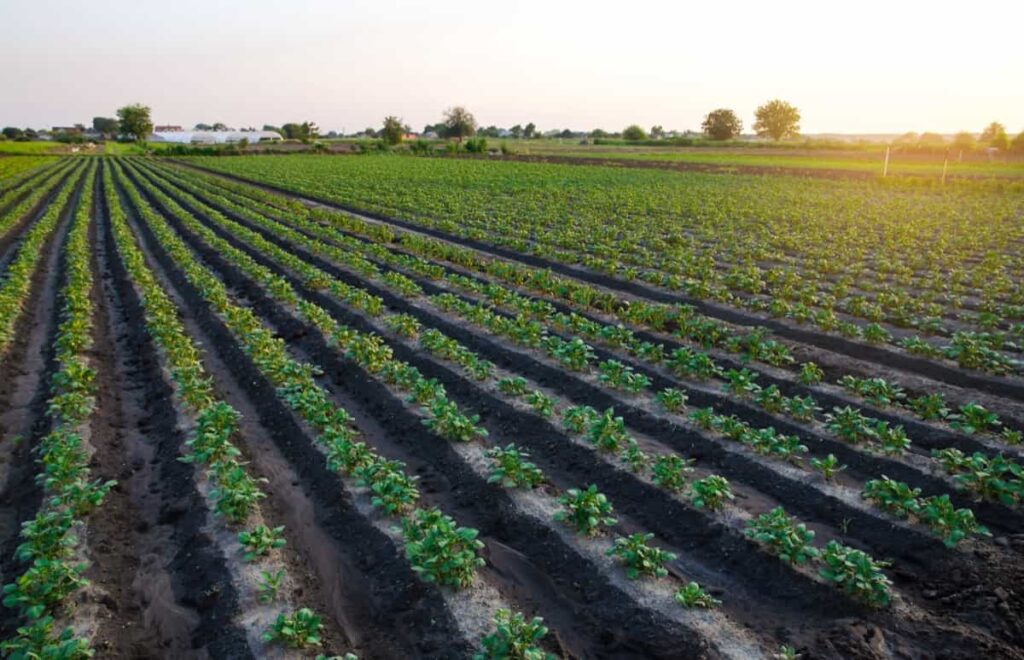
Planting and spacing
For planting, use the distance of 20 cm between tubers and 60 cm between ridges manually or mechanically. For sowing, use tractor operated semi-automatic or automatic planter. Dig a 6-8 inches deep trench and plant a piece of Potato with the eye pointing up. The planting distance varies with the size of the tubers. For example, if the diameter of the tuber ranges from 2.5-3.5 cm, use a planting distance of 60 cm x 15 cm, whereas if the diameter of the tuber is 5-6 cm, use a Spacing of 60×40 cm.
Requirement of irrigation for Potato agriculture
In summer, water the potato vines well, especially during the flowering stage of the plants and immediately following the flowering stage. For the best results, plants need a steady water supply during the flowering period. Keep potatoes watered regularly, as they need 1-2 inches of rain or water per week to grow. Whenever the leaves turn yellow and begin to die back, stop watering them. In preparation for harvest time, the potatoes will begin to heal. Farmers can increase potato yields by using drip irrigation.
Manuring
- 60 days before planting, green manure with lupin should be applied
- At the time of land preparation, sprinkle 75 g of horn manure into the soil by dissolving it in 40 liters of water
- At the time of land preparation, apply well-decomposed farm yard manure at a rate of 20 tons per acre
- Land preparation includes the application of biodynamic compost at a rate of 2 tons per acre
- Vermicompost application at 2 tons per acre during land preparation
- As part of the land preparation process, neem cake should be applied at a rate of 500 kilograms per acre.
- Biofertilizers like Azospirillum and Phosphobacteria are applied at 25 kg each/ha when the field is prepared.
- Spray 2 kg of cow pat pit in 40 liters of water per acre on the 45th, 60th, and 75th days after planting.
Weed control
It is vital to keep the field free of weeds during the critical period of weed competition, up to 60 days. On the 45th day, begin hoeing without disturbing stolons. The 60th day should be the day for the second hoeing and earthing up. Herbicides are not permitted, so weeds are controlled by:
- Weed seedlings should be flame-weeded before potato tops emerge – this is an expensive method
- Any large invasive weeds will be hand-weeded to a limited extent
- Spraying panchagavya with 3 percent foliar solution at ten-day intervals from the 1st month after sowing
- One month after sowing, spray 10% vermiwash five times at 15-day intervals
- An application of 25 grams of horn silica per acre in 50 liters of water on the 65th day after sowing is recommended
In case you missed it: Growing Pomegranate Organically in Maharashtra: Farming Practices and Production Guide
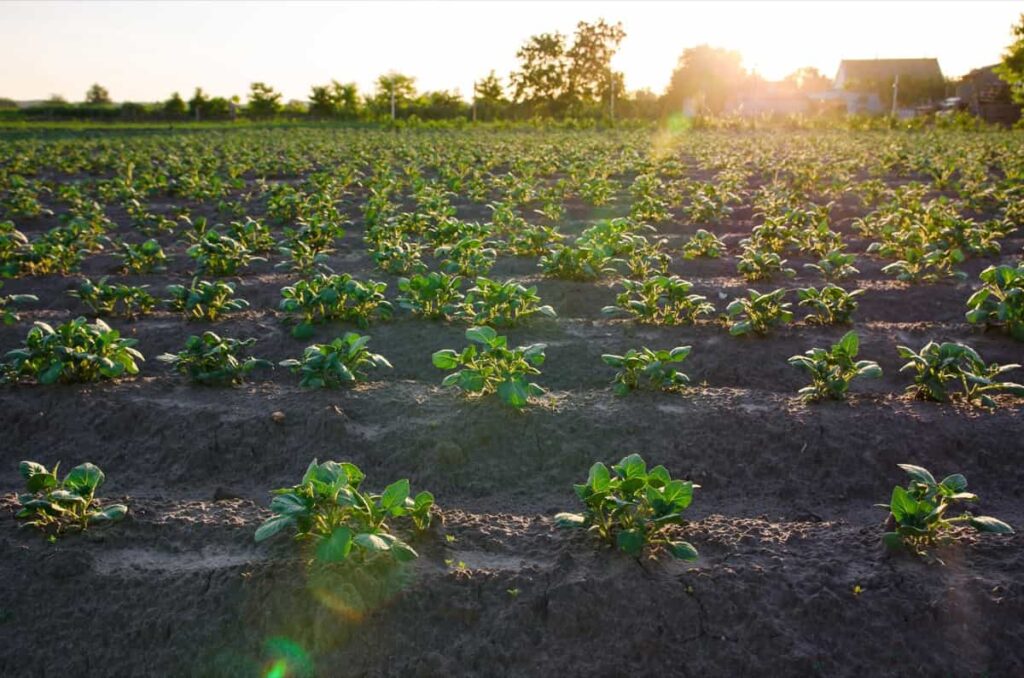
Crop rotation for Potato farming
The rotation of crops is one of the most critical steps for the growth of crops. Plant potatoes in different fields every year instead of the same one. As a result, crop rotation can increase soil fertility, reduce pest problems, conserve soil moisture, maintain soil structure, and increase soil organic matter.
Uttarpradesh: Potato-Wheat-Maize, Potato-Wheat-Paddy, Potato-Wheat-Green manure crop
Major pests in Potato farming and their organic control
Potato tuber moth
Symptoms of damage
- It is a pest of field and storage
- Larva tunnels into foliage, stem, and tubers
- Galleries are formed near tuber eyes
Control and management
- Avoid shallow planting of tubers. Plant the tubers at a 10 – 15 cm depth
- Install pheromone traps at eight numbers per acre
- At 60 days after planting, earth up the exposed tubers to prevent Potato tuber moth egg laying
- Spray 5% neem seed kernel extract on foliar damage to control it
Aphids
Symptoms of damage
- Aphids suck the sap of plants, and as a result, leaves turn pale and dry up.
- This pest also transmits various viral to potato plants
Control and manaement
- In the 45th, 60th, and 75th days after planting, spray 10% nettle leaf extract on the leaves
- In the 45th, 60th, and 75th days following sowing, spray 10% garlic-chili extract as foliar.
- A foliar spray of 3% neem oil is recommended
Cutworms
Symptoms of damage
- Young larvae feed on the epidermis of the leaves
- Older larvae come out at night and feed young plants by cutting their stems
- They also damage the tubers by eating away part of them
Control and management
- Moths will be attracted to light traps during summer
- Irrigate the field during the day with a sprinkler irrigation system to expose the larvae to bird predation
Major diseases in Potato farming and their organic control
Potato blight
Damage symptoms
- Water-soaked spots appear on leaves, increase in size, turn purple brown& finally, black color.
- White growth develops under the surface of leaves.
- In tubers, purplish brown spots spread to the entire surface on cutting; the affected tuber show rusty brown necrosis spreading from the surface to the center.
In case you missed it: Growing Pineapple Organically in West Bengal: Farming Practices and Production Guide
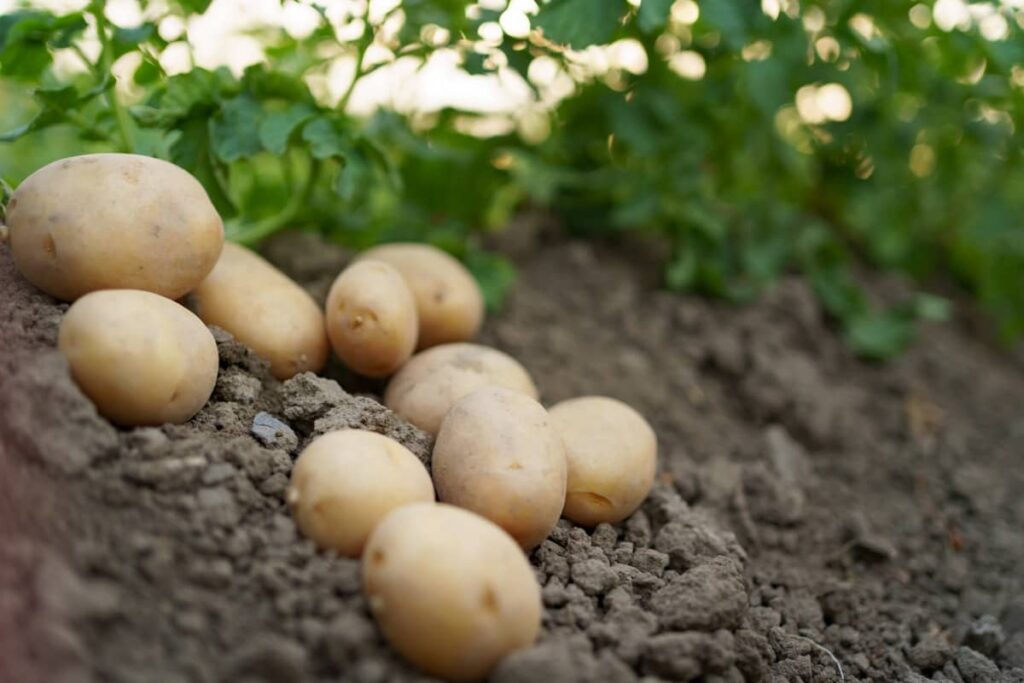
Control and managemet
- Seeds should be planted in a healthy, blight-free environment
- Blight-resistant varieties should be selected
- If the pressure of the blight is high, apply a permitted fungicide
- Get rid of ground creepers that serve as an infection source
- From one month after planting, spray Agni Hotra ash (200g of Agni Hotra ash soaked in one liter of cow urine for 15 days and diluted in 10 liters of water before spraying) three times at one-month intervals.
Nematodes
Damage symptoms
- Aboveground symptoms generally include stunted, yellowed, chlorotic, and dead plants.
- Infected plants are likely to wilt earlier under temperature or moisture stress. Therefore, infestations may occur without causing any aboveground symptoms.
- Feeding by root-knot nematode causes characteristic swellings, called galls, on roots. On heavily infested plants, egg masses appear as tiny round bumps on feeder roots.
Control and manegement
- Potatoes should not be grown in the same field year after year
- Vegetables and green manure should be rotated with crops
- It is possible to grow a resistant cyst nematode variety called Kufri Swarna
- Pseudomonas fluorescens can be applied at a rate of 10 kg/acre
- For potato cyst nematode control, sow mustard at the same time as potatoes, and harvest mustard greens 45 days after planting
Potato crop harvesting
After planting potatoes, the best time to harvest them is 75-120 days later, depending on the soil type, the area of sowing, and the variety. It is generally best to harvest a crop in the hills when the soil isn’t too wet. Make sure not to be too intrusive when digging around potatoes for fresh eating.
The larger new potatoes should be removed, but the smaller ones should stay in place to grow. The potato crop should be harvested when the leaves turn yellow and dry. Crops can be harvested slightly if there is high market demand. Harvest the soil when it is dry and rinse it before harvesting. Plants should be cut eight days before harvesting at ground level. Plows or potato diggers are used to do this.
Conclusion
The potato crop is one of the most profitable short-term agriculture crops. The global annual potato production is more than that of all vegetables. Owing to this high demand for potatoes, farmers look upon it as a profitable business. In addition, it serves as an excellent point to break the crop rotation from grass.
- Crops Grown in Summer Season: Best Choices for Summer Gardening
- Organic Pest Control for Tomato Farming
- How to Maximize Sheep Farming Profit
- Broccoli Varieties: Choosing the Right Cultivars for Your Farm
- How to Raise Pigs in Your Own Backyard: A Comprehensive Guide
- Budget Friendly Sheep Shed Ideas: Cheap and Low-Cost Tips
- How Much Do Cattle Farmers Make: Revenue Streams in Cattle Farming
- Management Pests and Diseases in Your Cotton Field
- Sheep Farming Business Plan for Beginners
- Aquaponic Farming at Home: A Step-By-Step Guide
- Profitable Village Farming Business Ideas in 2024
- High-Yield Aquaculture: Fast-Growing Fish for Farming
- Effective Fish Pond Construction Techniques for Beginners
- Irrigation and Water Management in Pineapple Farming
- Blossom to Harvest: Mastering Flowering and Pollination in Papaya Farming
- Pig Fattening Essentials: From Selection to Sale for Beginners
- Raising Wagyu Cattle: A Complete Guide for Premium Beef Production
- Soil Types and Their Water Holding Capacity
- Optimizing Irrigation Schedules for Coconut Groves for Enhanced Yield
- Espresso Your Garden: Coffee Grounds for Healthier Acid-Loving Plants
- The Best Soil Mix for Snake Plants: How to Mix Your Own Snake Plant Soil
- Green Thumb Success: Expert Tips for Cultivating Greenhouse Beans All Year Round
- Bloom All Year Round: The Ultimate Guide to Indoor Hyacinth Care
- Eco-Friendly Gardening: How to Make Liquid Fertilizer from Kitchen Waste
- Ultimate Guide to Grow Anise in Pots: Explore Seed Propagation to Harvesting
- Guide to Raising Chester White Pigs: Discover Breed Facts to Growth Management
- Mastering the Elegance: The Ultimate Guide to Weeping Cherry Tree Care, Planting, and Maintenance
- Ultimate Guide to Planting Garlic in Grow Bags: Growing Strategies for Beginners
- How to Fix Spider Plant Leaf-Related Problems: Natural and Organic Remedies
- 10 Reasons Why Your Tulsi Plant is Shedding Leaves: Home Remedies and Solutions
- Optimizing Growth and Yield: The Advantages of Palm Bunch Ash Fertilizer
- Utilizing Neem Oil Extract as a Natural Pesticide for Hydrangea
- From Soil to Harvest: Various Ways in Which Farmers Can Use AI Tools
- Steps to Encourage and Induce Citrus Flowers: A Comprehensive Guide
- How to Fix Snake Plant Leaf-Related Issues: Natural and Organic Remedies
- Transform Your Garden into a Fragrant Oasis with Raat Ki Rani (Night Blooming Jasmine)
